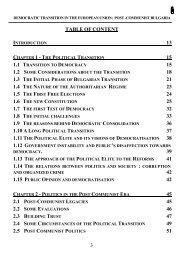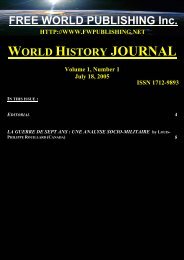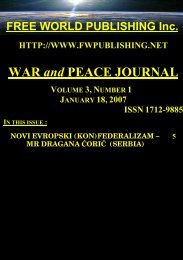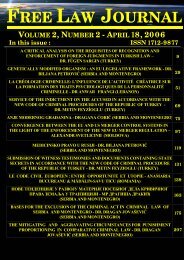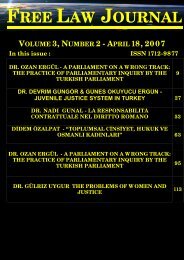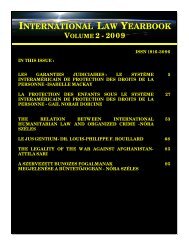Free_Law_Journal-Vol.. - Free World Publishing Inc.
Free_Law_Journal-Vol.. - Free World Publishing Inc.
Free_Law_Journal-Vol.. - Free World Publishing Inc.
Create successful ePaper yourself
Turn your PDF publications into a flip-book with our unique Google optimized e-Paper software.
FREE LAW JOURNAL - VOLUME 1, NUMBER 1 (18 JULY 2005)<br />
“BIS DE EADEM RE NE SIT ACTIO” PRINCIPLE IN THE<br />
FORMULARY SYSTEM OF ROMAN LAW OF PROCEDURE<br />
by<br />
Dr. GOKCE TURKOGLU-OZDEMIR*<br />
INTRODUCTION<br />
As it is known, Roman law of procedure, is developed in two main terms. The first one is called Ordo<br />
iudiciorum privatorum and the second one is called Cognitio extra ordinem. Ordo iudiciorum privatorum<br />
is also divided into two parts; legis actiones and formula proceedings. Legis actiones proceeding is used<br />
in the primitive times of Roman law. Because of this reason some of the regulations and institutions are<br />
not known during this proceeding. Roman law of procedure makes a progress mainly during the formula<br />
proceeding. But it can be definitely said that, the regulations made in the Cognitio extra ordinem mainly<br />
effected the current procedural law. In this article, we will will explain briefly how bis de eadem re ne sit<br />
actio principle is used in formulary procedure. Putting forward how this principle makes a progress during<br />
a long period of time will be useful to understand the principle better in current law systems.<br />
“BIS DE EADEM RE NE SIT ACTIO” PRINCIPLE<br />
“Bis de eadem re ne sit actio” or “ne bis in idem” principle, is put forward briefly, to prevent bringing an<br />
action more than once on the same contentious issue in Roman law of procedure 1 . This universal principle<br />
is valid in both Ordo iudiciorum privatorum and Cognitio extra ordinem procedures of Roman law,<br />
forbidding to maintain once again the same action with reference to same issue. Although it is known<br />
even in the initial times of Roman law that there can not be more than one definite judgement about a<br />
contentious subject 2 , bis de eadem re ne sit actio principle, which confirms this reality, shows its effects<br />
mostly in formulary system 3 .<br />
The decision given by the judge or judges 4 is called definite judgement. In Roman law definite judgement<br />
(res iudicata) is accepted as expressing the fact (res iudicata pro veritate accipitur) 5 . Therefore, it is<br />
* Asst. Prof. Dr. Dokuz Eylul Unv. Fac. of <strong>Law</strong>- Izmir TURKEY<br />
1 Wenger, L.; Institutes of the Roman <strong>Law</strong> of Civil Procedure, Transl. by H. O. Fisk, p. 189; Bis de eadem re ne sit actio<br />
principle is also in use, in modern law systems. In modern law systems, to apply the principle, the action must be ended and<br />
definite judgement must be given. But in formulary procedure of Roman law, completing the litis contestatio phase, is<br />
sufficient. According to this, in formulary system, even though the definite judgement could not be given for some reasons, bis<br />
de eadem re ne sit actio principle is applied.<br />
2 Gai. 4, 108; Alia causa fuit olim legis actionum. nam qua de re actum semel erat, de ea postea ipso iure agi non poterat nec<br />
omnino ita, ut nunci usus erat illis temporibus exceptionum; The rule was formerly different when the ancient method to<br />
procedure was employed, for when proceedings concerning a matter had once been instituted, no legal action could be taken<br />
with reference to it, nor was the employment of exceptions in those times customary, as it is now.<br />
3 Thomas, J. A. C.; Textbook of Roman <strong>Law</strong>, Amsterdam, 1976, p. 318; Provera, G.; La Pluris Petitio nel Processo Romano, I,<br />
La Procedura Formulare, Turin, 1958, p. 23.<br />
4 Zulueta, de F.; The Institutes of Gaius, Part II, Oxford, 1953, p. 225 sq; The number of the judges who prosecute the action,<br />
can change according to the type of the action. As a rule, the issue which is defined by joinder of issue phase, goes for trial to a<br />
single private citizen who is chosen from an list and empowered by the parties and praetor. Sometimes an arbiter who is a<br />
special iudex hears an action in which more is left to his discretion than in a strictum iudicium. Several iudices who are called<br />
GOKCE TURKOGLU-OZDEMIR - “BIS DE EADEM RE NE SIT ACTIO” PRINCIPLE IN THE FORMULARY SYSTEM OF ROMAN LAW OF PROCEDURE 141






